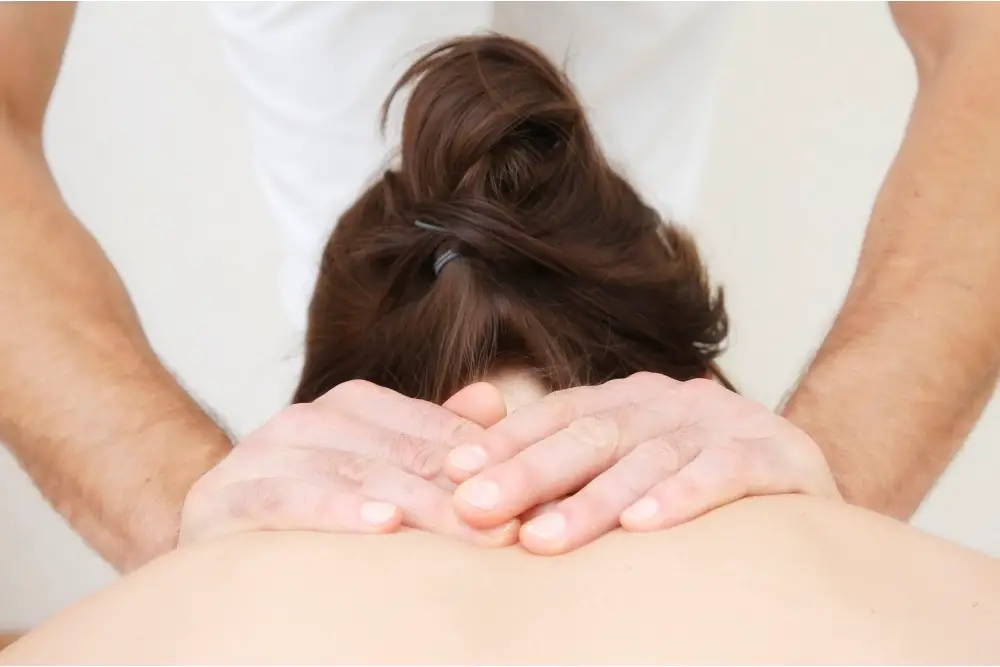Acupressure is an element of traditional Chinese medicine where pressure is applied to specific points of the body. These points are believed to correspond with the body’s meridian lines, along which your qi (vital life force energy) flows.
In traditional Chinese medicine, it is believed that a blockage of the qi flow can lead to illness and disease. The practice of acupressure allows these blockages to be moved and released, making your overall health better.
Below are some of the best acupressure points to help treat dizziness.
Acupoint: GV-20 (Other Names: The Governing Vessel-20/Bai Hui/Hundred Convergence)
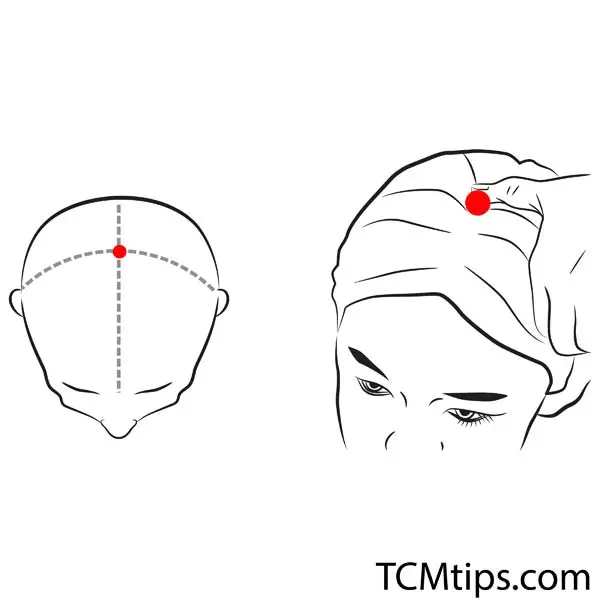
This is also known as GV 20, DU 20, or Hundred Meetings. To find this point you will rest the tops of your thumbs at the tops of your ears. As you do this, bring your middle fingers together over the top of your head, so that they meet in the center of your crown.
The uppermost point of the crown is where you should aim for. As you become more aware of the meridian lines in the body, you may be able to sense out Bai Hui more specifically. Feel for an area that seems energetically charged.
As you rest your fingertips here, try to focus your mental attention, localizing it to this area. This can be used to help relieve nasal obstructions, earache, memory problems, blurry vision, lethargy, epilepsy, mental disorders, headaches, and dizziness.
Acupoint: PC-6 (Other Names: Pericardium-6/Nei Guan/Inner Pass)
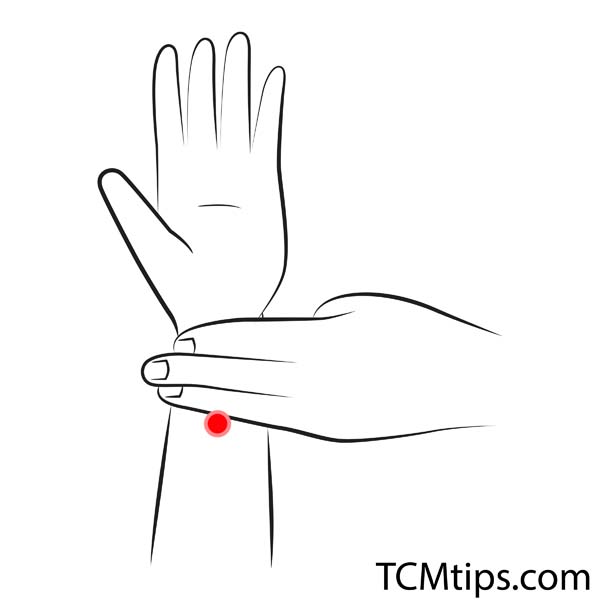
This is also referred to as Pericardium 6, Neiguan, or Inner Gate. This point can be found in the center of your wrist, about 3 finger-widths down from where your palm and arm join. Feel in the middle of your arm, in between the 2 tendons to locate this spot.
This point can be used to treat vertigo, dizziness, hemiplegia, apoplexy, coughs, asthma, depression, malaria, irritability, chest congestion, palpitations, and cardiac pain.
Acupoint: GB-20 (Other Names: Gallbladder-20/Feng Chi/Wind Pool)
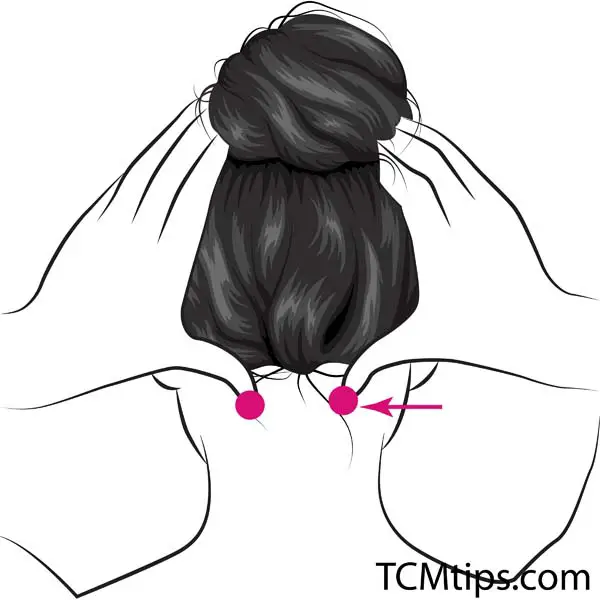
This is also referred to as Gall Bladder 20, Fengchi, and Wind Pool. This acupressure point is found at the base of the skull, where the top of your neck begins.
If you feel this region you will notice the thick and tendon-y muscle of the trapezius. Feel either side of this for smaller, soft depressions in your neck. These are the Wind Pool points.
Place the tips of your middle fingers into this area of your body, right in the center, aligned with your spinal column.
Slide them across your neck as you move your fingers apart until you feel them falling into the small depression. Apply a gentle circular pressure to both GB 20 points for between 1 and 3 minutes.
This acupressure point can be used to help treat hemiplegia, epilepsy, vertigo, and dizziness. It is also believed to help alleviate eye problems, high blood pressure, neurological disorders, headaches, neck and shoulder pain.
Acupoint: SI-17 (Other Names: Small Intestine-17/Tian Rong/Heavenly Appearance)

This is also referred to as SI 17, Small Intestine 17, Tianrong, and Celestial Appearance. This point can be found on both sides of your head, directly behind your ear lobes, in a small depression. Press here with your index finger tips with a constant pressure for at least 1 minute.
This can be used to treat dizziness, vertigo, nausea, deafness, tinnitus, ear irritation, swelling, and discharge.
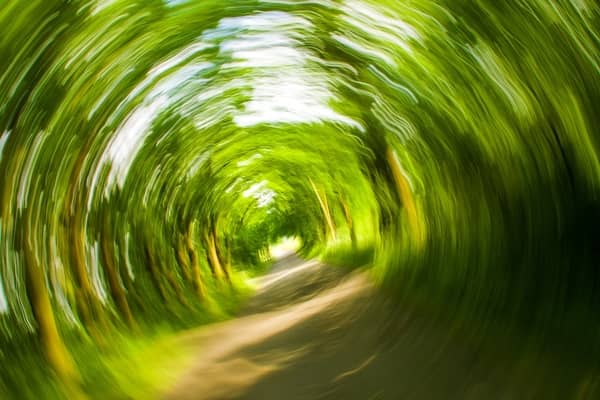
Acupoint: SI-19 (Other Names: Small Intestine-19/Ting Gong/Palace of Hearing)
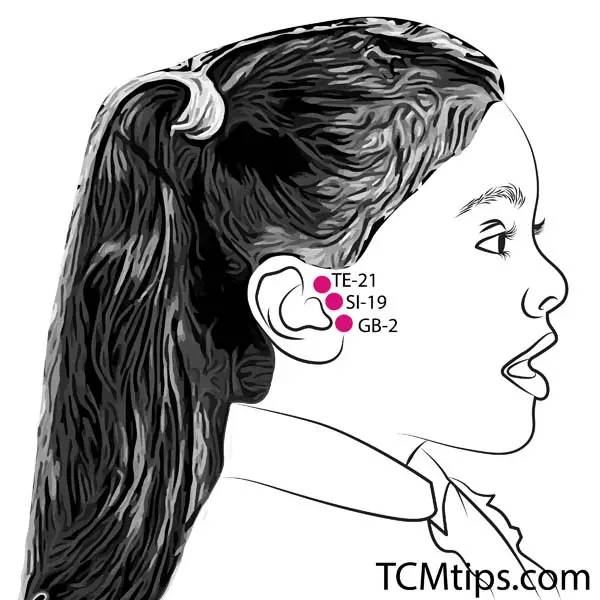
This is also referred to as Small Intestine 19, Tinggong, and Hearing Palace. To find this point, feel along your cheekbones as you open your mouth. Feel for the hollow, this is the SI 19 point.
Use the tips of your index finger on both hands and feel for this point on both sides of your face. Apply a firm and constant pressure for at least 1 minute. This point is known to relieve dizziness, epilepsy, mania, deafness, tinnitus, and toothache.
Acupoint: GV-26 (Other Names: The Governing Vessel-26/Ren Zhong/Middle of the Person)

This is also known as DU 26, Shuigou, or Water Trough. This is found in a region known as the philtrum, the little dip underneath your nose and above your lips. To find it, feel ⅔ of the way up the upper lip. This is typically used in first aid as it has such effective impacts on the body.
To activate this point, apply constant pressure to the region using the finger tip of your index finger. Continue this for 1 minute. It is known to treat nosebleeds, nasal discharge, and an inability to smell. It can also help with collapse, fainting, dizziness, epilepsy, spinal pain, emotional agitation, and cramps.
Acupoint: Bl-23 (Other Names: Urinary Bladder-23/Shen Shu/Kidney Transporter)

This is also referred to as UB 23, Urinary Bladder 23, Shenshu, and Kidney Shu. There are 2 of these points, one on either side. To find them, feel in your lower back to the sides of your spine. Start at waist level on your spine, and measure 2 finger-widths away, towards the sides of your body.
To activate these points, use your knuckles to rub the lower back vigorously for at least 1 minute. This can help to reduce lower back pain and boost the immune system. It is also believed to help reduce fainting, instability, dizziness, extreme weakness, and fatigue.
Acupoint: Bl-47 (Other Names: Urinary Bladder-47/Hun Men/Ethereal Soul Gate)

This is also referred to as UB 47, Urinary Bladder 47, Hunmen, and Door of the Ethereal Soul. These are located in line with the B 23 points, but are set at 4 finger-widths away from the spinal column on either side. It is often advised to use points B 23 and B 47 in conjunction.
To activate these points, use your knuckles to rub the lower back vigorously for at least 1 minute. This can help to reduce lower back pain and boost the immune system. It is also believed to help reduce fainting, instability, dizziness, extreme weakness, and fatigue.
Acupoint: KI-1 (Other Names: Kidney-1/Yong Quan/Gushing Spring)
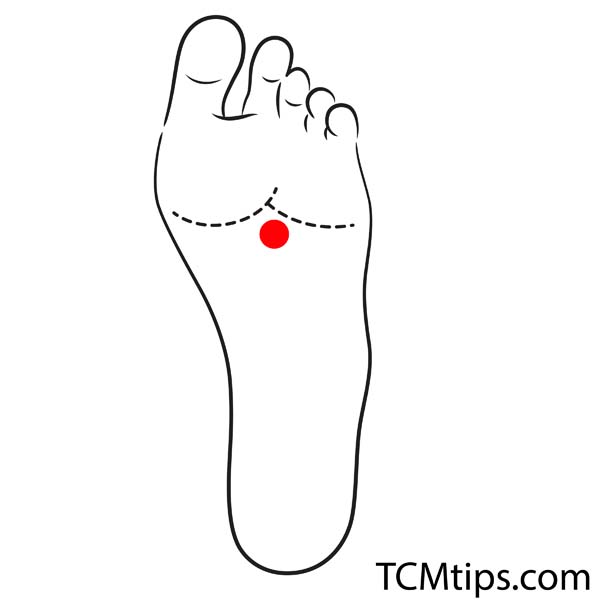
This point is also referred to as Kidney 1, Yongquan, or Gushing Spring. An ancient text, known as Golden Mirror, states that this point can be found “In the depression in the heart of the sole, as felt when the leg is stretched, the foot bent, and the toes curled.”
In simpler terms, slightly extend your foot so the arches are activated. It’s about a ⅓ of the way down the top of your foot, in the center. It is found near the base of the big toe.
It is advised that you picture roots extending out of the sole of your feet and digging into the ground. Imagine these roots traveling all the way to the center of the earth and your connection becoming increasingly stable and energized.
This point is traditionally used to calm the spirit by drawing energy downwards and grounding you. The best way to target KD 1 is to sit up straight in a chair with back support. Rest your ankle over the knee or thigh of the opposite leg.
Cradle your foot in your hand and massage the point with your thumb. Apply deep pressure in a circular motion for 2 to 3 minutes before repeating on the other side.
This point is also used to treat mania, anxiety, hypertension, headaches, sore throats, tinnitus, insomnia, lower back pain, hot flashes, night sweats, and palpitations.

Acupoint: ST-36 (Other Names: Stomach-36/Zu San Li/Leg Three Miles)

This point is also referred to as Stomach 36, Zusanli, or Leg Three Miles. The directions for finding Zusanli can be confusing, as they often mention 3 cun as a unit of measurement. This is the distance across the central knuckles of your 4 fingers when they are pressed together.
Bend your knee slightly and relax your leg as you feel for the base of your kneecap. When you can feel the central tendon running below, feel for 2 small dimples on either side.
Place the top of your fingers in the outer dimple and allow the rest of your fingers to gently fall down your shin. Where your pinky stops, this is the level of Zusanli.
Apply firm and deep pressure to this point on your leg (or both if you prefer). Use small, circular motions and continue this process for at least 2 to 3 minutes.
This point can also be used to give overall strength to the body, tone your muscles, and ground you.
Acupoint: Liv-3 (Other Names: Liver-3/Tai Chong/Supreme Rush)

This point is also referred to as Liver 3, Taichong, and Great Surge. To find this spot, you should feel for the dip on the top of your foot, in between the big and second toes. Place your middle and index finger tips in this spot on the top of both of your feet. Apply pressure in a circular motion for at least 30 seconds.
This spot can be used to treat menstrual issues, calm anxiety, reduce irritability and anger, and relieve digestive problems. It is also highly effective as a treatment for dizziness, weakness, fainting, headaches, hangovers, exhaustion, and mild nervous disorders.
Acupoint: ST-9 (Other Names: Stomach-9/Ren Ying/Man’s Prognosis)

This point is also referred to as Stomach 9, Renying and Man’s Welcome. To find it, you will need to look on the side of your neck. It is approximately level with the upper boundary of the Adam’s apple, on the outer side of the muscle located there.
This point is believed to help with fainting, dizziness, headaches, nausea, lower back pain, hypertension, chest tightness, sore throats, and asthma.

Try our Anti-Aging Gua Sha Tool designed to bring out your skin’s natural glow.
Best Gua Sha Product- Anti-Aging: The tool is designed to target 11 specific aging signs such as wrinkles and sagging skin. By following the 7-step routine, users can improve skin firmness and reduce fine lines naturally.
- Enhances Skincare Routine: It works effectively with serums and lotions, boosting absorption and efficacy of skincare products.
- Visible Skin Improvement: Users can expect a smoother complexion, reduced puffiness, and a more youthful appearance.
 P. Sze
P. Sze 